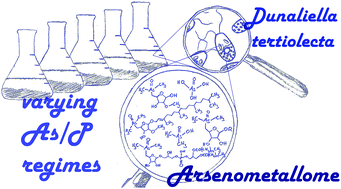当前位置:
X-MOL 学术
›
Metallomics
›
论文详情
Our official English website, www.x-mol.net, welcomes your feedback! (Note: you will need to create a separate account there.)
Arsenolipid biosynthesis by the unicellular alga Dunaliella tertiolecta is influenced by As/P ratio in culture experiments.
Metallomics ( IF 3.4 ) Pub Date : 2017-12-12 00:00:00 , DOI: 10.1039/c7mt00249a Ronald A Glabonjat 1 , Josef Ehgartner , Elliott G Duncan , Georg Raber , Kenneth B Jensen , Frank Krikowa , William A Maher , Kevin A Francesconi
Metallomics ( IF 3.4 ) Pub Date : 2017-12-12 00:00:00 , DOI: 10.1039/c7mt00249a Ronald A Glabonjat 1 , Josef Ehgartner , Elliott G Duncan , Georg Raber , Kenneth B Jensen , Frank Krikowa , William A Maher , Kevin A Francesconi
Affiliation

|
The influence of arsenate and phosphate levels in water on the formation of arsenic-containing lipids (arsenolipids) and water-soluble arsenicals by a unicellular marine alga was investigated by exposing Dunaliella tertiolecta to five regimes of arsenic and phosphate, and determining the biosynthesized organoarsenicals with HPLC/mass spectrometry. Under all conditions, the major arsenolipid produced by D. tertiolecta was the novel phytyl 5-dimethylarsinoyl-2-O-methyl-ribofuranoside (AsSugPhytol546) representing ca. 35–65% of total arsenolipids. The new compound contains a phytol aglycone and a methoxy group replacing a sugar hydroxyl – two structural features not previously observed for arsenolipids. Minor arsenolipids were several previously reported arsenosugar phospholipids (AsSugPLs, in particular AsSugPL958 and the previously unknown AsSugPL978), the relative quantities of which increased with increasing phosphate exposure, and an arsenic-containing hydrocarbon (AsHC360), which remained unaffected by the different treatments. The relative amount of total arsenolipids produced by D. tertiolecta remained remarkably constant (ca. 45% of total As) and independent of the culture conditions. In contrast, with rising As-concentrations we observed an increase of hydrophilic arsenicals, which were dominated by arsenate and arsenosugars. The results highlight a possible major difference in arsenic biochemistry between macroalgae and unicellular algae with potential implications for how various algae handle their natural arsenic exposure in the world's oceans.
中文翻译:

在培养实验中,单细胞藻类杜氏杜氏藻(Dunaliella tertiolecta)的砷脂生物合成受As / P比的影响。
通过将杜氏藻暴露于五种砷和磷酸盐溶液中并测定生物合成的有机砷,研究了单细胞海藻中水中砷和磷酸盐水平对含砷脂质(砷脂)和水溶性砷形成的影响。HPLC /质谱。在所有条件下,D。tertiolecta产生的主要砷脂是代表约3个碱基的新型植酸基5-甲基二甲基亚砷酰基-2- O-甲基-呋喃呋喃糖苷(AsSugPhytol546)。总砷脂的35–65%。这种新化合物包含一个植醇糖苷配基和一个取代糖羟基的甲氧基,这是砷脂以前没有观察到的两个结构特征。次要砷脂是先前报道的几种砷糖糖脂(AsSugPLs,尤其是AsSugPL958和以前未知的AsSugPL978),其相对量随着磷酸盐暴露量的增加而增加,以及一种含砷的碳氢化合物(AsHC360),其不受不同处理的影响。叔D. teriolecta产生的总砷脂的相对量保持显着恒定(约占总As的45%,并且不受培养条件的影响。相反,随着砷浓度的增加,我们观察到亲水性砷的增加,而砷和砷糖占主导地位。结果表明,大型藻类和单细胞藻类在砷生物化学上可能存在重大差异,这可能对各种藻类如何处理世界海洋中的天然砷暴露产生潜在影响。
更新日期:2017-12-12
中文翻译:

在培养实验中,单细胞藻类杜氏杜氏藻(Dunaliella tertiolecta)的砷脂生物合成受As / P比的影响。
通过将杜氏藻暴露于五种砷和磷酸盐溶液中并测定生物合成的有机砷,研究了单细胞海藻中水中砷和磷酸盐水平对含砷脂质(砷脂)和水溶性砷形成的影响。HPLC /质谱。在所有条件下,D。tertiolecta产生的主要砷脂是代表约3个碱基的新型植酸基5-甲基二甲基亚砷酰基-2- O-甲基-呋喃呋喃糖苷(AsSugPhytol546)。总砷脂的35–65%。这种新化合物包含一个植醇糖苷配基和一个取代糖羟基的甲氧基,这是砷脂以前没有观察到的两个结构特征。次要砷脂是先前报道的几种砷糖糖脂(AsSugPLs,尤其是AsSugPL958和以前未知的AsSugPL978),其相对量随着磷酸盐暴露量的增加而增加,以及一种含砷的碳氢化合物(AsHC360),其不受不同处理的影响。叔D. teriolecta产生的总砷脂的相对量保持显着恒定(约占总As的45%,并且不受培养条件的影响。相反,随着砷浓度的增加,我们观察到亲水性砷的增加,而砷和砷糖占主导地位。结果表明,大型藻类和单细胞藻类在砷生物化学上可能存在重大差异,这可能对各种藻类如何处理世界海洋中的天然砷暴露产生潜在影响。



























 京公网安备 11010802027423号
京公网安备 11010802027423号